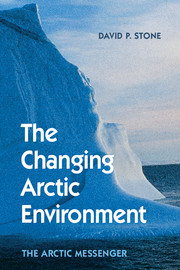Book contents
- Frontmatter
- Dedication
- Contents
- Acknowledgements
- Acronyms
- 1 Personal Beginnings
- PART I THE CHANGING ARCTIC
- PART II WORKING TOGETHER
- 3 The Arctic Messenger Gains a Voice: The Arctic Monitoring and Assessment Programme
- PART III WHAT IS THE PRESENT STATE OF KNOWLEDGE?
- PART IV WHAT DOES ALL THIS MEAN?
- Appendix I The Intergovernmental Panel on Climate Change (IPCC)
- Appendix II What Will Happen in the Future If We Do Nothing or If We Try Very Hard to Aggressively Reduce GHG Emissions: Projected Change Under Different Emission Scenarios
- Appendix III Some Geophysical Background Notes Related to Climate and Weather
- Appendix IV Orbital Forcing
- Appendix V The Concept of Commitment
- Bibliography
- Credits
- Index
3 - The Arctic Messenger Gains a Voice: The Arctic Monitoring and Assessment Programme
from PART II - WORKING TOGETHER
Published online by Cambridge University Press: 05 February 2015
- Frontmatter
- Dedication
- Contents
- Acknowledgements
- Acronyms
- 1 Personal Beginnings
- PART I THE CHANGING ARCTIC
- PART II WORKING TOGETHER
- 3 The Arctic Messenger Gains a Voice: The Arctic Monitoring and Assessment Programme
- PART III WHAT IS THE PRESENT STATE OF KNOWLEDGE?
- PART IV WHAT DOES ALL THIS MEAN?
- Appendix I The Intergovernmental Panel on Climate Change (IPCC)
- Appendix II What Will Happen in the Future If We Do Nothing or If We Try Very Hard to Aggressively Reduce GHG Emissions: Projected Change Under Different Emission Scenarios
- Appendix III Some Geophysical Background Notes Related to Climate and Weather
- Appendix IV Orbital Forcing
- Appendix V The Concept of Commitment
- Bibliography
- Credits
- Index
Summary
Remember that to change your mind and follow him who sets you right is to be none the less free than you were before.
Marcus Aurelius, MeditationsBefore the late 1980s, any attempt to work cooperatively in the circum- polar Arctic had to deal with the grim realities of the Cold War. The Warsaw Pact and the NATO countries obsessively distrusted one another. Any suggestions that topics of mutual interest might exist and could be tackled cooperatively were met with deep suspicion and formidable hurdles on both sides of the Iron Curtain. It was a poisonous milieu and certainly not one likely to welcome a proposal to monitor and assess the health of the circumpolar Arctic environment. Imagine suggesting to either the United States or the Soviet Union before the arrival of Mikhail Gorbachev that cooperative studies should be put in place to evaluate the distribution of radionuclides around such potential sources as sunken nuclear submarines or military and civilian marine radioactive waste sites! But this is exactly what happened in the Gorbachev years.
During the Cold War, there were some bright spots. In the years immediately following World War II, the United Nations divided the world into a number of economic commissions – one of which became the United Nations Economic Commission for Europe (UNECE). Despite its misleading title, the UNECE was composed of the countries of Europe north of the Mediterranean, the Soviet Union, Canada and the United States. This membership remains the same today – except we now have the “new” states that emerged from the disappearance of such confederations as the Soviet Union and Yugoslavia.
In the 1970s, the East and West realized that the transboundary atmospheric transport of sulphur and nitrogen products of power generation and metal smelting was leading to widespread acidification and the degradation of forest and freshwater aquatic ecosystems.
- Type
- Chapter
- Information
- The Changing Arctic EnvironmentThe Arctic Messenger, pp. 23 - 40Publisher: Cambridge University PressPrint publication year: 2015
- 1
- Cited by



